Modern warfare is increasingly dependent on microelectronics capabilities that sense the environment, convert the signals into data streams, process the information, and generate a response. In this sense, Aerospace and Defense (A-D) systems are quite similar to commercial systems that perform communications and computations, while taking advantage of the advancement …
Read More »Risind threat of rising Mass shooting incidents, Security Forces deploying technologies AI based Gunfire detection systems, and imaging radars
Assaults by firearm kill about 11,000 people in the US each year, which translates to a roughly 1-in-370 lifetime chance of death from gun violence. That’s almost 50% more likely than the lifetime odds of dying while riding inside a car, truck, or van. These measures also suggest Americans are …
Read More »Countries develop Sonic Weapons, the silent weapons used in counter-terrorist and crowd control settings
Sonic weapons employ extremely high-power sound waves to disrupt or destroy the eardrums of a target and cause severe pain or disorientation. This is usually sufficient to incapacitate a person. Less powerful sound waves can cause humans to experience nausea or discomfort. The use of these frequencies to incapacitate persons …
Read More »New radars can detect Drones carrying IEDs, biological or chemical agents, a critical technology for Counter UAS systems
The increased commercialization of drones is increasing the risks that these drones can be used by terrorists and criminals. The small drones such as a quadcopter or model airplane are readily available and it is highly probable that existing technology would allow unfriendly forces to retrofit them, giving the aircraft …
Read More »Muography employs cosmic ray particles Muons, to detect shielded nuclear contraband, to objects deeply buried up to thousands of meters below the earth’s surface
Muons are subatomic particles that behave a lot like electrons but are around 200 times heavier. As the US Department of Energy explains, “Muons created in the atmosphere constantly hit every inch of the Earth’s surface and pass through almost any substance.” Many scientists have noted that measuring the …
Read More »Graphene-based ink for printed electronics and Wearable electronic textiles (e-textiles)
The emerging field of printed electronics requires a suite of functional materials for applications including flexible and large-area displays, radio frequency identification tags, portable energy harvesting and storage, biomedical and environmental sensor arrays, and logic circuits. To enable these technologies, functional materials must be integrated with suitable patterning technologies, …
Read More »G/ATOR, a three-dimensional Multisession AESA Radar to detect and fire low-observable targets, will be integrated with the Integrated Air and Missile Defense (IAMD) System
G/ATOR is an expeditionary, three-dimensional, short- to medium-range multirole X-band radar system designed to detect low-observable, low-radar cross-section targets such as rockets, artillery, mortars, cruise missiles, and unmanned aircraft systems. The Ground/Air Task Oriented Radar (G/ATOR) is a single materiel solution for the mobile Multi-Role Radar System and Ground Weapons …
Read More »DARPA SC2 challenge use AI to optimize spectrum usage in Wireless Networks and Adaptive Radios to cooperatively share or dominate congested spectrum
Ongoing wireless revolution is fueling a voracious demand for access to the radio frequency (RF) spectrum around the world. In the civilian sector, consumer devices from smartphones to wearable fitness recorders to smart kitchen appliances are competing for bandwidth. Around 50 billion wireless devices are projected to be vying for …
Read More »High Power electromagnetic technologies enable Electromagnetic Weapons on Aircrafts, combat drones and missiles
A high-powered microwave weapon (HPM) is type of Directed Energy Weapon (DEW) for employing radio frequency energy against a variety of targets. They are principally counterelectronic weapons and could be used to destroy any enemy electronic systems, including radars, computer systems and communications infrastructures. Electromagnetic weapons can destroy, intercept or jam …
Read More »Militaries developing Cognitive and Adaptive Radar to counter advanced electronic threats and mitigate spectrum congestion
Today’s radars face an ever increasingly complex operational environment, intensified by the numerous types of mission/modes, number and type of targets, non-homogenous clutter and active interferers in the scene. The EM cluttered environment is a growing problem for ground- based and airborne radar systems. This problem is becoming critical …
Read More » International Defense Security & Technology Your trusted Source for News, Research and Analysis
International Defense Security & Technology Your trusted Source for News, Research and Analysis









